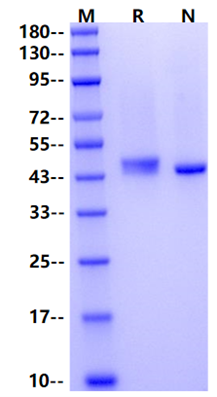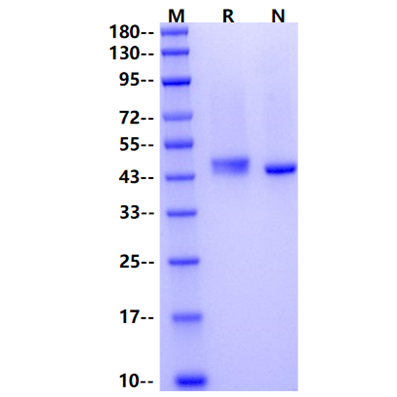1μg (R: reducing conditions, N: non-reducing conditions).
Product Details
Product Details
Product Specification
| Species | Mouse |
| Synonyms | RAGE |
| Accession | Q62151 |
| Amino Acid Sequence | Gly23-Ala342, with C-terminal 8*His GQNITARIGEPLVLSCKGAPKKPPQQLEWKLNTGRTEAWKVLSPQGGPWDSVARILPNGSLLLPATGIVDEGTFRCRATNRRGKEVKSNYRVRVYQIPGKPEIVDPASELTASVPNKVGTCVSEGSYPAGTLSWHLDGKLLIPDGKETLVKEETRRHPETGLFTLRSELTVIPTQGGTHPTFSCSFSLGLPRRRPLNTAPIQLRVREPGPPEGIQLLVEPEGGIVAPGGTVTLTCAISAQPPPQVHWIKDGAPLPLAPSPVLLLPEVGHEDEGTYSCVATHPSHGPQESPPVSIRVTETGDEGPAEGSVGESGLGTLALAGGGSHHHHHHHH |
| Expression System | HEK293 |
| Molecular Weight | 43-48kDa |
| Purity | >95% by SDS-PAGE |
| Endotoxin | <0.1EU/μg |
| Conjugation | Unconjugated |
| Tag | His Tag |
| Physical Appearance | Lyophilized Powder |
| Storage Buffer | PBS, pH7.4 |
| Reconstitution | Reconstitute at 0.1-1 mg/ml according to the size in ultrapure water after rapid centrifugation. |
| Stability & Storage | · 12 months from date of receipt, lyophilized powder stored at -20 to -80℃. · 3 months, -20 to -80℃ under sterile conditions after reconstitution. · 1 week, 2 to 8℃ under sterile conditions after reconstitution. · Please avoid repeated freeze-thaw cycles. |
| Reference | 1. Review Invest Clin . 2010 Jun;51(2):257-68. |
Background
RAGE(Receptor for Advanced glycosylation End Products) is a 35kD transmembrane receptor of the immunoglobulin superfamily. It is also called AGER. Its name comes from its ability to bind advanced glycation endproducts (AGE), which include chiefly glycoproteins the glycans of which have been modified non-enzymatically through the Maillard reaction. RAGE represents an important factor in innate immunity against pathogens, but it also interacts with endogenous ligands, resulting in chronic inflammation. Studies have demonstrated the role of RAGE in inflammatory cell recruitment and leukocyte extravasation across the endothelial barrier.
Picture
Picture
SDS-PAGE



